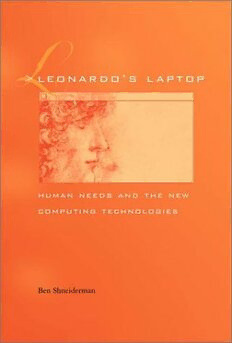
Leonardo's Laptop: Human Needs and the New Computing Technologies PDF
Preview Leonardo's Laptop: Human Needs and the New Computing Technologies
> leonardo’s laptop > leonardo’s laptop human needs and the new computing technologies Ben Shneiderman The MIT Press Cambridge, Massachusetts London, England ©2002 Massachusetts Institute of Technology All rights reserved. No part of this book may be reproduced in any form by any elec- tronic or mechanical means (including photocopying, recording, or information storage and retrieval) without permission in writing from the publisher. This book was set in Garamond Three by Achorn Graphic Services Inc. Printed and bound in the United States of America. Library of Congress Cataloging-in-Publication Data Shneiderman, Ben. Leonardo’s laptop : human needs and the new computing technologies / Ben Shneiderman. p. cm. Includes bibliographical references and index. ISBN 0-262-19476-7 (hc. : alk. paper) 1. Electronic data processing. 2. Human-computer interaction. 3. Technological forecasting. I. Title. QA76 .S5145 2002 004—dc21 2001056277 For Jenny, Sara, Anna contents Preface> x 1 inspiration for the new computing> 1 Leonardo’s Humble Start Envisioning the New Computing The Old Computing Gives Birth to the New Computing About This Book The Skeptic’s Corner 2 unusable at any bandwidth> 21 Raising Public Awareness Unusable Interfaces Getting to the New Computing The Skeptic’s Corner 3 the quest for universal usability> 35 Defining Universal Usability Coping with Technology Variety Accommodating Diverse Users Bridging the Gap Between What Users Know and What They Need to Know The Skeptic’s Corner 4 new methods, new goals> 51 Shifting to the New Computing Methods for Achieving User-Centered Designs Moore’s Law Reexamined From AI to UI—Artificial Intelligence to User Interfaces Guidelines for User-Centered Designs Why Focus on Human-Computer Interaction? The Skeptic’s Corner 5 understanding human activities and relationships> 75 Why Do We Use Computers? Four Circles of Relationships Four Stages of Activities An Activities and Relationships Table The Eyes Have It! Visual Information Mobility and Ubiquity: Palmtops, Fingertips, InfoDoors, WebBushes The Skeptic’s Corner viii > Contents 6 the new education: e-learning> 111 Why Can’t Every Student Earn an A? Teaching and Technology Applying Collect-Relate-Create-Donate A Science Festival Scenario The Skeptic’s Corner 7 the new commerce: e-business> 133 Why Shouldn’t You Get the Deal You Want? Opportunities for Merchants Advantages for Customers Personalization and Customization To Trust or Not to Trust The Skeptic’s Corner 8 the new medicine: e-healthcare> 157 Why Should You Ever Be Sick? Enabling Physicians Empowering Patients A Medical Scenario The Skeptic’s Corner 9 the new politics: e-government> 183 Why Shouldn’t You Get What You Want From Your Government? Getting What You Want from Government Getting the Government You Want Open Deliberation The Skeptic’s Corner 10 mega-creativity> 207 Leonardo’s Creativity Inspirationalists, Structuralists, and Situationalists Three Levels of Creativity: Everyday, Evolutionary, Revolutionary A Framework for Mega-Creativity Integrating Creative Activities Consultation Through Negotiated Expectations An Architectural Scenario The Skeptic’s Corner ix > Contents 11 grander goals> 233 The Old Computing and the New Computing The Next Leonardo The Skeptic’s Corner Notes> 245 References> 251 Index> 259 preface Computing today is about what computers can do; the new computing will be about what people can do. As users of contemporary technology, we are often angry and frustrated because computers are not in harmony with our needs and abilities. We feel powerless and do not see a role for the individual in the process of technological innovation. This book is primarily designed to raise users expectations of what they should get from technology and to empower both users and developers to invent computers that enhance our lives and our world. We can accelerate the movement toward the “new computing” by adopting Leonardo da Vinci as an inspirational muse. His integrative spirit, combining science with art and engineering with aesthetics, can help us envision more successful and satisfying experiences with informa- tion and communications technologies. With our new sense of empowerment, we can challenge technology developers to more diligently focus on user needs so that they can pro- duce more effective technologies. Such improvements can come quickly to learning, commerce, healthcare, and government. Small innovations such as jewel-like medical sensors and fingertip computing, will be cou- pled with large innovations such as secure and immediate worldwide access to medical information and million-person communities that bridge the digital divide and enable consensus seeking and conflict resolution. acknowledgments So many people helped me to see the future and inspired me. Several of them helped by commenting on draft chapters: Ben Bederson, Alison Druin, Amy Friedlander, Christopher Fry, Jean Gasen, Ruth Guyer, Brian Kahin, Bill Killam, Charles Kreitzberg, Jonathan Lazar, Nancy Leveson, Peter Levine, Henry Lieberman, Richard Mushlin, Catherine Plaisant, Ron Rice, Ariel Sarid, George Schneider, Norman Schneider- man, Barbara Tversky, and Ron Weissman. I am especially appreciative of the people who read the full manuscript at various stages in its development: Harry Hochheiser, Bill Kules, Kent Norman, Stephan Parker, Arkady Pogostkin, Jenny Preece, Anne Rose, Helen Sarid, and xi > Preface the anonymous reviewers. My students over the years, graduates and undergraduates, have been more than a testing ground for these ideas, they are the continuing motivation for my development. I hope they will put these ideas to work and then refine them still further. A contin- uing inspiration and source of wisdom is my partner and wife, Jenny Preece. College Park, Maryland > leonardo’s laptop
